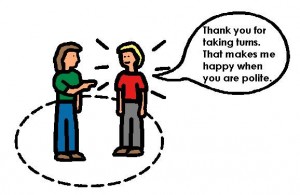
Parenting, Resources  Taking turns is one of the most critical social skills needed in day-to-day life. Turn taking is necessary when it comes to developing friendships, communicating with others and playing games.
Turn taking is not an innate skill. It needs to be taught, not in a classroom setting but in real life situations.
Here are 9 ideas that will help teach turn taking to your child. Have more ideas? Please share!
Taking turns is one of the most critical social skills needed in day-to-day life. Turn taking is necessary when it comes to developing friendships, communicating with others and playing games.
Turn taking is not an innate skill. It needs to be taught, not in a classroom setting but in real life situations.
Here are 9 ideas that will help teach turn taking to your child. Have more ideas? Please share!
 – builds on the natural interest of many children to play with blocks. You could also try using regular blocks and taking turns placing one on top of the other to see how tall you can build a tower. This also assists in working cooperatively.
– builds on the natural interest of many children to play with blocks. You could also try using regular blocks and taking turns placing one on top of the other to see how tall you can build a tower. This also assists in working cooperatively.
Taking Turns: how to make it easier for your child with special needs
 Taking turns is one of the most critical social skills needed in day-to-day life. Turn taking is necessary when it comes to developing friendships, communicating with others and playing games.
Turn taking is not an innate skill. It needs to be taught, not in a classroom setting but in real life situations.
Here are 9 ideas that will help teach turn taking to your child. Have more ideas? Please share!
Taking turns is one of the most critical social skills needed in day-to-day life. Turn taking is necessary when it comes to developing friendships, communicating with others and playing games.
Turn taking is not an innate skill. It needs to be taught, not in a classroom setting but in real life situations.
Here are 9 ideas that will help teach turn taking to your child. Have more ideas? Please share!



